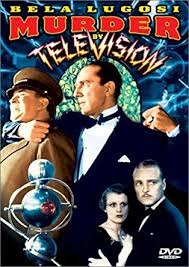
“It created an interstellar frequency which is… the death ray.”
In the early days of television Professor James Houghland (Charles Hill Mailes) has invented a revolutionary way of sending television signals all over the world. The invention is in great demand. Several people want it. He is offered 5 million dollars for his invention by Donald Jordan (Charles K. French), the owner of Continental Tel-E-Vising Corporation but he turns it down. Jordan asks Houghland’s assistant Arthur Perry (Bela Lugosi) to try to change his mind. After Arthur leaves his twin brother Edwin shows up pretending to be Arthur. He agrees to get the drawing of Houghland’s invention for 100,000 dollars.
Houghland invites some friends over to observe a demonstration of his invention. During the broadcast Houghland falls dead. Police Chief Nelson (Henry Mowbray) shows up to investigate.
Several of the guests are suspected: Houghland’s assistant Perry who was not in the parlor when the murder happened. Donald Jordan, who bribed Perry to steal the invention’s drawings, Richard Grayson (George Meeker), the ambitious young television engineer who had promised to secure the invention’s secrets for his company, and Dr. Henry Scofield (Huntley Gordon) who was also away from everyone else in the parlor supposedly making a phone call to an unknown number. Toss in a couple a red herrings for good measure. What’s a mystery movie from the 30’s without them?
During the investigation Jordan shows up and says that he thinks he knows who the killer is. He explains that he agreed to pay Arthur to obtain Houghland’s drawings. When the police go to question Perry he is found stabbed. The knife used belongs to Ah Ling (Allen Jung), the houseboy. Suspicion now lands on him, but not for long.
“Murder by Television” AKA “The Houghland Murder Case” was released in 1935 and was directed by Clifford Sanforth. It is one of the few movies that Lugosi did that is not in the horror genre. It’s sort of an Old Dark House movie but televised.
Comic relief is in the form of racial stereotypes with Allen Jung as Ah Ling, the houseboy and Hattie McDaniel as Isabella, the cook. Hattie McDaniel was “Mammy” in “Gone With The Wind” (1939), for which she won the Academy Award for Best Supporting Actress, the first Oscar won by a black entertainer.
The television equipment props were borrowed from Los Angeles area researchers who were working on experimental Television. The equipment they borrowed was worth $75,000, over twice the $35,000 production budget for the entire film.
Time has not been nice to this movie. I haven’t seen a transfer yet that looks good. Some worse than others. Bela Lugosi plays twin brothers in this murder mystery. His performance is OK. He’s not a prominent character and there was only so much he could do with the part. The movie is a little far-fetched and silly and there are a few leaps in logic. It’s also not easy to follow. I had to re-watch several portions of it to understand how it pieced together. Add to it a bad transfer and you may lose patience with it all together. The audience for this rare film would be lovers of obscure Mysteries or Lugosi completists. Even they may have a hard time with it. It could be a lot of work for little reward.

